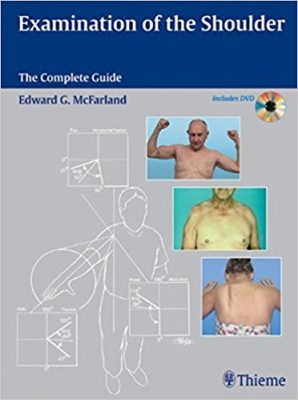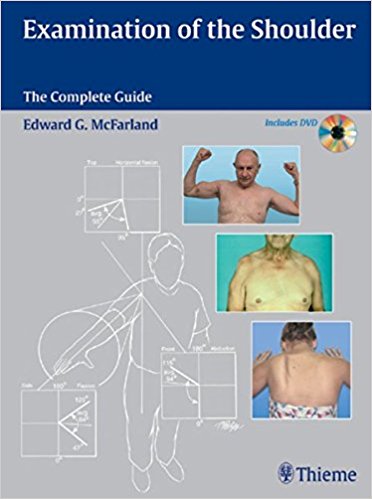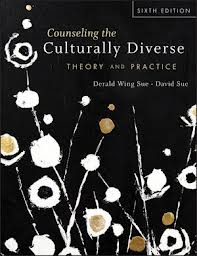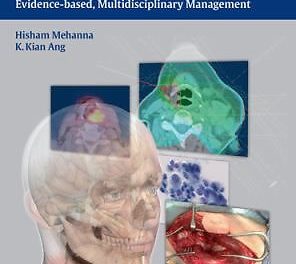 Editor-in-Chief: Edward G. McFarland, MD
Editor-in-Chief: Edward G. McFarland, MD
Editors: Tae Kyun Kim, MD; Hyung Bin Park, MD, George L. Rassi, MD; Harpreet Gill, MD; and Ekavit Kayurapan, MD
Publisher: Thieme – 282 pages
Book Review by: Nano Khilnani
The shoulder is a particularly complex system consisting of four distinct joints and 21 separate muscles. Those examining the shoulder must sort out the complaints of the patients into a ‘coherent diagnostic whole’ in order to develop a ‘comprehensive treatment program’ points out Dr. Frank W. Jobe, who wrote the Foreword for this book. Because of its complex anatomy and physiology, pain in the shoulder “can have a bewildering array of potential diagnoses,” he writes.
Eighteen specialists including the editors, in orthopedics, orthopedic surgery, physical medicine and rehabilitation, physical therapy, sports medicine, and injury research, from the United States and eight other countries – Australia, Greece, India, Japan, Lebanon, New South Wales, South Korea, and Thailand – authored the seven chapters of this book. We provide you the titles of the chapters to give you an overview of the contents of this book:
- General Principles of Shoulder Examination
- Shoulder Range of Motion
- Strength Testing
- Rotator Cuff Disease and Impingement
- Instability and Laxity
- Examination of the Biceps, Tendon, and Superior Labrum Anterior and Posterior (SLAP) Lesions
- The Acromioclavicular and Sternoclavicular Joints
Included with this book on the inside back cover is a DVD that provides information on how to perform examinations of the shoulder, and it includes examples of abnormal examinations
This book has been developed for medical students, fellows, and trainees in orthopedics, rehabilitative medicine, kinesiology, and general practice. This book also provides relatively newer shoulder examination techniques, which would be beneficial to established practitioners.
It is also useful for athletic trainers such as gym owners, or those interested in developing a better physique or just being fit.
Dr. Jobe describes this work as “compact reference in the examination room for a quick review or recollection of the difference between the diagnostic criteria for a SLAP lesion versus a rotator cuff problem versus a traction injury of one of the girdle muscles.”
The editors write that this book has two basic goals. In their own words, they are:
First, it is meant to be a complete handbook of examination of the shoulder that can be used by any person who will be examining shoulders. Any person of any level of medical training should be able to look at any of these examination methods and be able to do them clinically.
Second, it is to evaluate critically how we examine shoulders so that we can improve examination of this joint. The goal is for the person examining the shoulder to understand that some tests used and reported in the literature are useful and some are not.
Among the valuable features of this book are:
- A review of the principles of shoulder examination
- Coverage of all topics from range of motion measurements to laxity testing and shoulder instability
- Critical analyses of the usefulness and accuracy of examination practices – why some tests work and some do not
- Tables and figures describing the factors that can complicate evaluation and how to overcome them
Among other topics of information and useful benefits, this book enables readers to gain a comprehensive understanding of shoulder anatomy and physiology, including causes and processes of shoulder pain. The accompanying DVD is a great bonus containing biomechanical models demonstrating shoulder motion, examples of abnormal findings, and much more that can be learned much better and faster through a video than with static images.
Editor-in-Chief:
Edward G. McFarland, MD is Vice Chairman of the Department of Orthopedic Surgery; and Professor in the Division of Sports Medicine and Shoulder Surgery at the Johns Hopkins University School of Medicine in Baltimore, Maryland.
Editors:
Tae Kyun Kim, MD, PhD is Assistant Professor in the Department of Orthopedic Surgery at Seoul National University, and is affiliated with Bundang Hospital in Seoul, South Korea.
Hyung Bin Park, MD, PhD is Assistant Professor in the Department of Orthopedic Surgery at Seoul National College, and is affiliated with Bundang Hospital in Seoul, South Korea.
George L Rassi, MD, PhD is Consultant in the Department of Orthopedic Surgery at Saint George University Medical Center in Beirut, Lebanon.
Harpreet Gill, MD, PhD is Consultant in the Department of Orthopedic Surgery at SPS Apollo Hospitals in Ludhiana, India.
Ekavit Kayurapan, MD is Clinical Instructor in the Department of Orthopedic Surgery at Mahidol University; and is affiliated with Sriraj Hospital in Bangkok, Thailand.







